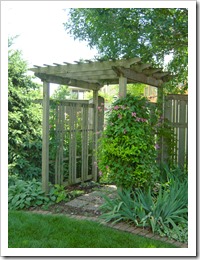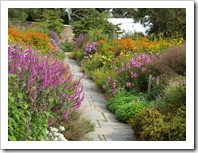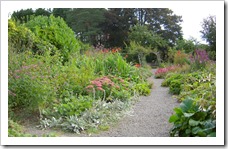In my last posting, I introduced the topic of creating an English cottage-style garden in an American yard. These lovely, cozy gardens were the gardens of the peasant class for centuries, but in the last 150 years they have become popular among all sorts of home owners on both sides of the Atlantic.
Space in a typical cottage garden was at a minimum, so they were usually filled to overflowing with plants and flowers of all sorts and colors – a colorful mix of plants in homey disarray.
Cottage gardens are so personal and individual that it is hard to give rules or designs that will work for every gardener. But the elements that went into those early cottage gardens also form the basis of what we strive for to get that look today.
1. Variety of plant material
Margery Fish, of East Lambrook Manor, said that cottage garden plants should be “simple, tough, and treasured”. Old varieties, especially heirloom plants rather than modern hybrids are perfect in a cottage garden. “Pass-along plants”, plants received from friends, are also at home in this type of garden. A mix of annuals, perennials, roses, fruits, vegetables, and herbs will look great. The key is to mix colors, textures, heights, and have something in bloom at all times.
2. Profusion without pretension
A cottage garden looks packed full without looking planned. Exuberance rather than neatness is the goal with plants tumbling over paths and planted in layers of different heights. Self-seeding of annuals and perennials is encouraged.
3. Structures and plants for height
Cottage gardens include structures to provide visual height and places for plants to climb, such as arches, arbors, pergolas, trellises and obelisks. Tall-growing plants and flowers can also add height to the back of a bed.
4. Walkways and pathways
Crathes Castle and Hill House in Scotland
Pathways in cottage gardens are usually made of simple materials which harmonize with the materials of the home and other hard surfaces. Brick, flagstone, crushed rock and grass are typical materials. Walkway and path edges do not need to be sharp and tidy – plants spilling over the edges are a part of the cottage garden appeal.
5. Minimal lawn area
Americans have a love affair with the grassy lawn, but in a cottage garden, less is more. The ideal is some grass in the midst of the garden rather than a garden beside the grass. Grassy areas in the cottage garden are used to set off the beds or to link areas of the garden together. The Edwardian-era display garden at the Malvern Flower Show illustrates how the grass acts as “negative space”, an area of calm and ease amid the busy plantings.
6. Sheltered by wall, fence, trees or shrubs
Here at the Manor House in Upton Grey, the garden is given protection by placing it lower than the house. If you don’t have the luxury of a stone or brick wall, consider using a fence or tall shrubs behind the plantings.
And there’s one more element that I think is essential:
7. Every cottage garden should include a place to sit, relax and enjoy the garden
(by Mary)
Photos: All photos by Mary Wallace, Martha Liska, or in the public domain.










Nice article, beautiful pictures. Joyce
By: Joyce Wenz on June 28, 2014
at 8:15 am
This is such an informative and enjoyable post. I really look forward to reading about your English adventures and interests. Keep them coming!
By: Anonymous on July 1, 2014
at 6:36 pm